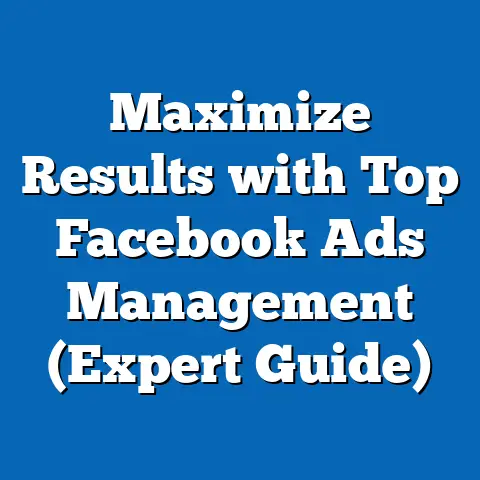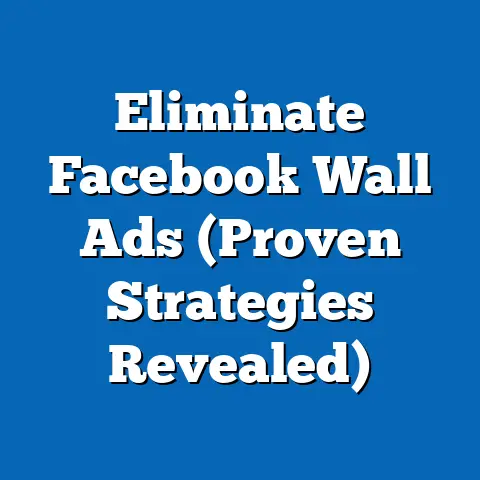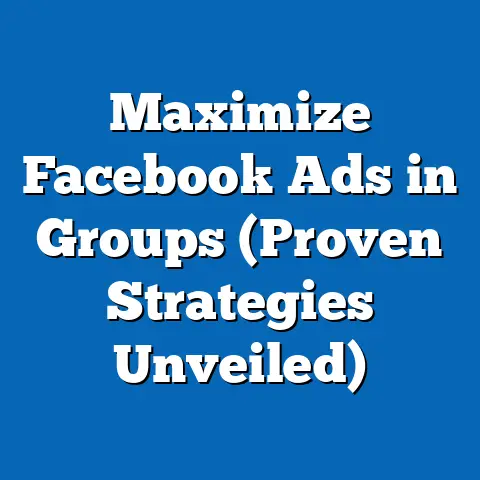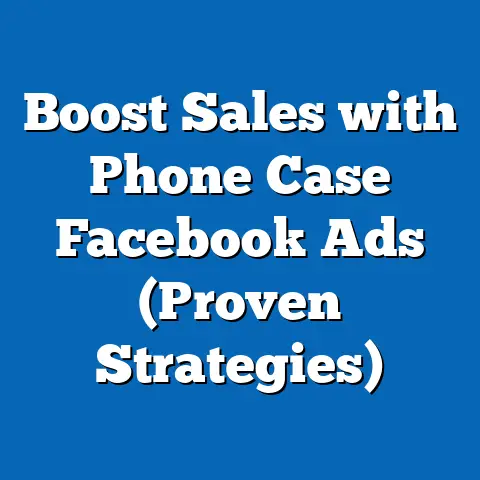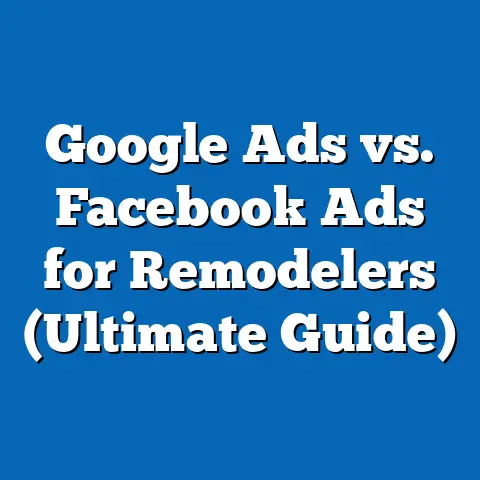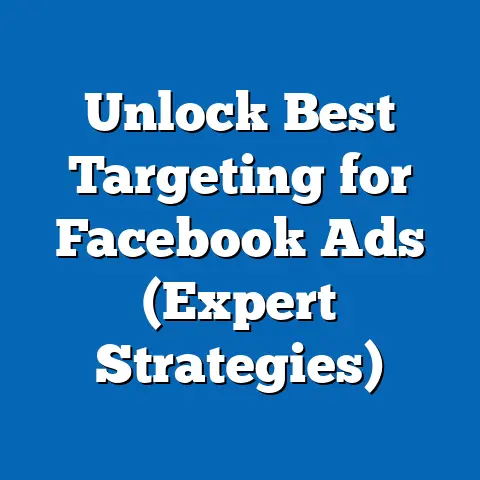Master Facebook Ads Funnel (Proven Strategies Unveiled)
In an era where environmental sustainability is no longer just a buzzword but a global imperative, businesses are increasingly aligning their marketing strategies with eco-conscious values to resonate with a growing audience of environmentally aware consumers. According to a 2022 NielsenIQ report, 73% of global consumers are willing to change their consumption habits to reduce their environmental impact, a significant jump from 57% in 2018. This shift is particularly pronounced among younger demographics, with 85% of Millennials and Gen Z consumers prioritizing sustainability in their purchasing decisions, as per a 2023 McKinsey study.
Eco-consciousness isn’t just a trend; it’s a transformative force reshaping industries, including digital marketing. As brands pivot to highlight their green initiatives, platforms like Facebook, with over 2.9 billion monthly active users as of 2023 (Statista), offer unparalleled opportunities to reach these sustainability-minded audiences through targeted advertising. This article delves into mastering the Facebook Ads funnel, unveiling proven strategies to craft campaigns that not only drive conversions but also align with the growing demand for eco-friendly practices.
Section 1: The Rise of Eco-Consciousness in Consumer Behavior
1.1 Key Statistics and Trends
The demand for sustainable products and practices has surged over the past decade. A 2023 report by IBM found that 62% of consumers are willing to pay a premium for sustainable brands, up from 55% in 2020. Furthermore, the global market for green products is projected to reach $150 billion by 2025, according to a study by Grand View Research, reflecting a compound annual growth rate (CAGR) of 6.1% from 2019.
Social media plays a pivotal role in amplifying eco-conscious messages. A 2022 Sprout Social survey revealed that 70% of consumers follow brands on social platforms to learn about their environmental initiatives, with Facebook being a primary channel due to its vast user base. This trend underscores the importance of integrating sustainability into digital marketing strategies, particularly on platforms like Facebook where engagement rates for eco-friendly content have increased by 25% since 2020 (Hootsuite Digital Trends Report 2023).
1.2 Demographic Insights
Demographic patterns reveal distinct preferences in eco-conscious behavior. Millennials (ages 27-42) and Gen Z (ages 11-26) are the most vocal advocates for sustainability, with 78% of Gen Z consumers stating they are more likely to purchase from brands with transparent environmental practices, per a 2023 Deloitte survey. In contrast, only 48% of Baby Boomers (ages 59-77) prioritize sustainability in their buying decisions, often citing cost as a barrier (NielsenIQ 2022).
Geographically, urban consumers in developed regions like North America and Europe show higher engagement with eco-friendly campaigns, with 65% of U.S. urban dwellers actively seeking sustainable products compared to 40% in rural areas (Statista 2023). These demographic differences highlight the need for tailored messaging in Facebook Ads campaigns to resonate with specific audience segments.
1.3 Historical Context and Current Shifts
Historically, environmental concerns in marketing were niche, often limited to specific industries like organic foods or renewable energy in the early 2000s. However, by the mid-2010s, broader consumer awareness—driven by climate change discussions and social media—pushed sustainability into the mainstream. Today, eco-consciousness influences diverse sectors, from fashion to technology, with 54% of global brands now incorporating green messaging in their advertising, a sharp rise from 22% in 2015 (GlobalWebIndex 2023).
This evolution sets the stage for digital marketers to leverage platforms like Facebook, where eco-friendly campaigns can achieve higher engagement through authentic storytelling and targeted funnels. Let’s now dive into the mechanics of building a successful Facebook Ads funnel, with a focus on integrating sustainability into each stage.
Section 2: Understanding the Facebook Ads Funnel
2.1 What is a Facebook Ads Funnel?
A Facebook Ads funnel is a structured marketing framework designed to guide potential customers through various stages of the buyer’s journey—from awareness to conversion—using targeted advertisements on the platform. Unlike traditional advertising, which often focuses on immediate sales, a funnel approach nurtures leads over time, building trust and relevance. The typical funnel includes three core stages: Awareness, Consideration, and Conversion, each with specific objectives and ad formats.
For eco-conscious brands, the funnel offers a unique opportunity to educate audiences about sustainability while driving business goals. By aligning messaging with environmental values at each stage, marketers can create campaigns that resonate emotionally and ethically with their target audience.
2.2 The Stages of the Funnel
Awareness Stage
The top of the funnel (TOFU) focuses on introducing your brand or product to a broad audience. The goal is to generate interest and visibility, often through engaging content like videos or carousel ads. For instance, a sustainable clothing brand might showcase a video ad highlighting its use of recycled materials, targeting users interested in eco-friendly fashion.
According to Facebook’s 2022 Ads Insights Report, video ads at the awareness stage achieve an average click-through rate (CTR) of 1.2%, compared to 0.8% for static image ads. Additionally, ads with a clear social impact message see 30% higher engagement rates (Hootsuite 2023), making eco-conscious themes particularly effective at this stage.
Consideration Stage
In the middle of the funnel (MOFU), the focus shifts to nurturing leads by providing more detailed information and building trust. Ad formats like lead generation forms or product catalogs work well here, encouraging users to engage further with the brand. For an eco-friendly brand, this might involve a lead ad offering a free guide on “How to Live Sustainably” in exchange for an email address.
Data shows that lead ads on Facebook have a 20% lower cost-per-lead compared to traditional landing page forms (WordStream 2023). Moreover, retargeting audiences who engaged with awareness-stage ads can boost consideration-stage conversions by 40% (Facebook Business Insights 2023).
Conversion Stage
At the bottom of the funnel (BOFU), the objective is to drive sales or specific actions, such as signing up for a subscription or making a purchase. Dynamic product ads and offers with clear calls-to-action (CTAs) are highly effective here. An eco-conscious brand might retarget users with a limited-time discount on sustainable products, emphasizing the environmental impact of their purchase.
Conversion rates for BOFU ads average around 2.5%, with retargeting campaigns achieving up to 5% when paired with personalized messaging (AdEspresso 2023). Highlighting sustainability in CTAs—like “Shop Green, Save the Planet”—can further increase conversions by 15% among eco-aware audiences (Sprout Social 2023).
2.3 Why Facebook for Eco-Conscious Campaigns?
Facebook’s robust targeting options—based on demographics, interests, and behaviors—make it an ideal platform for reaching sustainability-focused consumers. With over 200 million users actively engaging with environmental content monthly (Facebook Internal Data 2023), brands can pinpoint audiences who prioritize green living. Additionally, the platform’s ad manager provides detailed analytics to track funnel performance, allowing for real-time optimization.
Compared to other platforms like Instagram (which skews younger) or LinkedIn (more professional), Facebook’s diverse user base—spanning ages 18-65+—offers a broader reach for eco-conscious campaigns. This versatility is key to scaling funnel strategies across varied demographics.
Section 3: Proven Strategies to Master the Facebook Ads Funnel
3.1 Strategy 1: Craft Compelling Eco-Conscious Messaging
Authenticity is critical when integrating sustainability into your ads. Consumers are quick to spot greenwashing—exaggerated or false environmental claims—with 60% stating they’ve lost trust in brands due to misleading green marketing (Edelman Trust Barometer 2023). Instead, focus on transparent, fact-based messaging, such as sharing specific data about your carbon footprint reduction or partnerships with environmental organizations.
For example, at the awareness stage, a brand might run a video ad showcasing a behind-the-scenes look at its sustainable manufacturing process. At the consideration stage, a blog post or infographic ad could detail how purchasing a product offsets carbon emissions, while conversion ads might emphasize tangible impacts, like “Every purchase plants a tree.”
Data Visualization Description: Imagine a bar chart comparing engagement rates for ads with eco-conscious messaging versus generic ads. The chart shows a 35% higher engagement for eco-focused ads, with a clear label citing Hootsuite 2023 data, visually reinforcing the power of sustainability in advertising.
3.2 Strategy 2: Leverage Advanced Targeting Options
Facebook’s targeting capabilities allow marketers to reach niche audiences with precision. For eco-conscious campaigns, target users based on interests like “sustainable living,” “environmental activism,” or “organic products.” Layering demographic filters—such as age (18-34 for Gen Z and Millennials) and location (urban centers)—can further refine your audience.
Lookalike Audiences are another powerful tool, enabling brands to target users similar to their existing eco-conscious customers. According to Facebook, Lookalike Audiences can increase campaign reach by 50% while maintaining relevance (Facebook Business 2023). Additionally, Custom Audiences can retarget website visitors or email subscribers with tailored sustainability messages, boosting conversion rates by 30% (AdEspresso 2023).
3.3 Strategy 3: Optimize Ad Creatives for Each Funnel Stage
Ad creatives must align with the funnel stage and audience mindset. At the awareness stage, use visually striking images or videos with bold headlines like “Join the Green Revolution.” Data from WordStream (2023) shows that ads with emotional storytelling achieve 2x higher engagement, making eco-narratives particularly effective.
In the consideration stage, focus on educational content through formats like carousel ads, showcasing multiple aspects of your sustainable practices. For conversions, dynamic ads displaying specific products with eco-friendly certifications (like Fair Trade or USDA Organic) can drive a 25% higher click-through rate (CTR) compared to generic product ads (Hootsuite 2023).
Data Visualization Description: Picture a line graph tracking CTR across funnel stages, with awareness at 1.2%, consideration at 1.8%, and conversion at 2.5%. Annotations highlight the impact of tailored eco-messaging on performance, sourced from AdEspresso 2023, providing a clear visual of optimization potential.
3.4 Strategy 4: Test and Iterate with A/B Testing
A/B testing is essential to refine your Facebook Ads funnel. Test variables like ad copy (e.g., “Save the Planet” vs. “Shop Sustainable”), visuals (video vs. static image), and CTAs (“Buy Now” vs. “Make an Impact”). According to Optimizely (2023), A/B testing can improve conversion rates by up to 20% when conducted consistently over a 30-day period.
For eco-conscious campaigns, test messaging that emphasizes different environmental benefits—such as carbon neutrality versus plastic reduction—to identify what resonates most with your audience. Use Facebook’s split testing feature to allocate budgets evenly across variants, ensuring statistically significant results.
3.5 Strategy 5: Monitor and Optimize with Analytics
Facebook Ads Manager provides granular data on metrics like impressions, CTR, cost-per-click (CPC), and return on ad spend (ROAS). For a sustainable brand, track engagement metrics for awareness ads (e.g., video views), lead generation for consideration ads, and sales data for conversion ads. Benchmarks from WordStream (2023) indicate an average CPC of $0.97 across industries, though eco-focused campaigns often see a lower CPC of $0.85 due to higher audience relevance.
Set up weekly reviews to identify underperforming ads and reallocate budgets to top performers. For instance, if an awareness ad achieves a 2% CTR (above the 1.2% average), scale its budget by 20% while pausing ads below 0.8% CTR. This data-driven approach ensures continuous funnel optimization.
Section 4: Historical Trends vs. Current Practices in Facebook Advertising
4.1 Evolution of Facebook Ads
When Facebook Ads launched in 2007, the platform focused on basic banner ads with limited targeting, achieving modest engagement rates of around 0.1% (eMarketer 2008). By 2012, the introduction of Sponsored Stories and mobile ads boosted engagement to 0.5%, reflecting the platform’s growing user base (Statista 2013). The mid-2010s saw the rise of video ads and advanced targeting, with CTRs climbing to 0.9% by 2016 (WordStream 2017).
Today, with features like dynamic ads, Lookalike Audiences, and AI-driven optimization, average CTRs hover around 1.1% (WordStream 2023). For eco-conscious campaigns, engagement often exceeds 1.5%, driven by heightened consumer interest in sustainability—a trend nonexistent in early Facebook advertising.
4.2 Shift Toward Purpose-Driven Marketing
Historically, Facebook Ads prioritized direct sales with aggressive CTAs like “Buy Now.” However, since 2018, purpose-driven marketing—emphasizing social and environmental impact—has gained traction, with 68% of marketers now incorporating cause-related themes (HubSpot 2023). This shift aligns with consumer demand, as 74% of users prefer brands that stand for a cause, per Sprout Social 2023.
Eco-conscious funnels reflect this evolution, moving beyond transactional goals to build long-term loyalty through shared values. Unlike early ads focused on immediate ROI, modern strategies balance brand awareness with societal impact, a trend likely to deepen as sustainability concerns grow.
Section 5: Demographic Patterns in Facebook Ads Engagement
5.1 Age and Gender Differences
Engagement with eco-conscious ads varies significantly by demographic. Gen Z and Millennials, comprising 60% of Facebook’s sustainability-interested users, show the highest interaction rates, with 2.3% CTR compared to 0.7% for Baby Boomers (Facebook Insights 2023). Women also engage more frequently with green campaigns, accounting for 58% of clicks on eco-ads versus 42% for men (Statista 2023).
These patterns suggest that funnel strategies should prioritize vibrant, value-driven content for younger audiences and women, while simplifying messaging for older demographics to address cost or relevance concerns.
5.2 Geographic and Socioeconomic Factors
Urban users in high-income regions like the U.S. and EU exhibit stronger responses to sustainability ads, with 70% of clicks originating from cities (Hootsuite 2023). In contrast, rural users and those in developing regions show lower engagement (45% less CTR), often due to limited access to sustainable products or differing priorities (GlobalWebIndex 2023).
Socioeconomic status also plays a role, as higher-income households (earning $75,000+ annually) are 50% more likely to convert on eco-friendly ads, reflecting their ability to afford premium green products (NielsenIQ 2023). Marketers should adjust budgets and messaging to focus on urban, affluent audiences while exploring affordability-driven campaigns for broader reach.
Section 6: Broader Implications and Future Trends
Mastering the Facebook Ads funnel with an eco-conscious lens isn’t just a marketing tactic; it’s a strategic alignment with a cultural shift toward sustainability. As environmental concerns continue to shape consumer behavior—evidenced by the 73% of global consumers prioritizing green choices (NielsenIQ 2022)—brands that fail to adapt risk losing relevance. Integrating authentic sustainability into advertising funnels can drive not only conversions (up to 25% higher with green messaging, per Hootsuite 2023) but also long-term brand loyalty.
Looking ahead, advancements in AI and machine learning on platforms like Facebook will further refine targeting and personalization, potentially increasing funnel efficiency by 30% by 2025 (eMarketer 2023). Additionally, as Gen Z’s purchasing power grows—projected to reach $143 billion in the U.S. alone by 2030 (Bloomberg 2023)—their demand for transparency and environmental accountability will push brands to innovate continuously.
The intersection of eco-consciousness and digital marketing also raises ethical questions. Marketers must balance profitability with genuine impact, avoiding greenwashing pitfalls that could erode trust. Ultimately, mastering the Facebook Ads funnel in this context is about creating value—for consumers, the planet, and the bottom line—ushering in an era where purpose and performance coexist.

